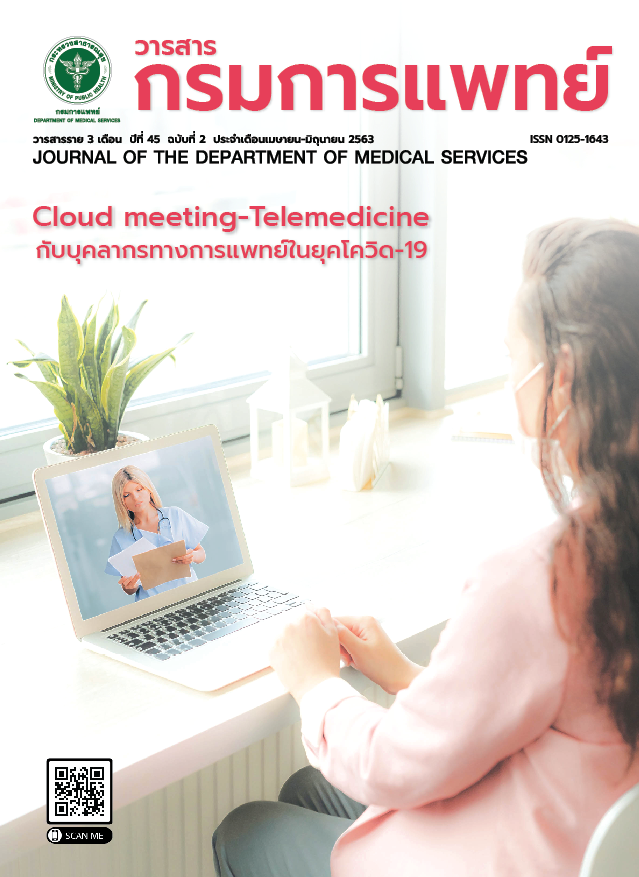การทบทวนอัตราค่าบริการการแพทย์ฉุกเฉิน ภายใต้โครงการพัฒนา ข้อเสนอ UCEP ด้านการเงินการคลัง
คำสำคัญ:
การทบทวน อัตราค่าบริการ, การเบิกจ่าย การแพทย์ฉุกเฉิน ฉุกเฉินวิกฤตบทคัดย่อ
ภูมิหลัง: กลไกการเบิกจ่ายค่าชดเชยค่าบริการทางการแพทย์ฉุกเฉินในปัจจุบัน ใช้วิธีการเบิกจ่ายตามอัตราที่กำหนดแยกรายการ หรือ fee schedule หรือ อัตราค่าบริการการแพทย์ฉุกเฉิน แต่พบช่องว่างสำหรับการพัฒนาอยู่มาก เพื่อให้สามารถเบิกค่าใช้จ่ายได้ครบถ้วนและปรับปรุงการทำงานของหน่วยงานที่เกี่ยวข้องให้สามารถบริหารงบประมาณได้มีประสิทธิภาพมากที่สุด จึงต้องศึกษาทบทวนรวมถึงการปรับปรุงอัตราและรายการค่าบริการดังกล่าว
วัตถุประสงค์: (1) ทบทวนอัตราค่าบริการการแพทย์ฉุกเฉิน ตามการเบิกจ่ายรายหมวดค่าบริการการแพทย์ฉุกเฉิน (2) ข้อมูลรายการอัตราค่าบริการที่ไม่มีในอัตราค่าบริการการแพทย์ฉุกเฉิน และปัญหาในการเบิกจ่ายค่ารักษาพยาบาล
วิธีการ: กระบวนการศึกษาแบบผสม (mixed method) เชิงปริมาณ ใช้ข้อมูลการเบิกจ่ายค่าบริการการแพทย์ฉุกเฉิน ภายใต้ “ โครงการพัฒนาข้อเสนอ UCEPด้านการเงินการคลัง” จากฐานข้อมูล ปีงบประมาณ พ.ศ. 2560 ที่สถานพยาบาลให้บริการผู้ป่วยฉุกเฉินส่งเบิกจ่ายมายังสำนักงานหลักประกันสุขภาพแห่งชาติ การวิจัยเชิงคุณภาพ ใช้แบบสัมภาษณ์ปัญหาในการให้บริการ ข้อมูลรายการที่ไม่มีในอัตราค่าบริการการแพทย์ฉุกเฉิน และปัญหาในการเบิกจ่ายค่ารักษาพยาบาลในผู้ป่วยฉุกเฉินวิกฤต
ผล: พบว่า 1. จำนวนรายการเบิกจ่ายค่าบริการการ แพทย์ฉุกเฉิน ที่ถูกเรียกเก็บคิดเป็น ร้อยละ 23.18 ของจำนวนรายการในอัตราค่าบริการการแพทย์ฉุกเฉิน ทั้งสิ้น 9,647 รายการ2. ราคาการเรียกเก็บส่วนใหญ่จะสูงกว่าราคาอัตราค่าบริการการแพทย์ฉุกเฉิน โดยหมวดค่ายาและสารอาหารทางหลอดเลือดมีค่าเรียกเก็บสูงสุด สูงถึง 714.29 เท่า ของราคาในอัตราค่าบริการการแพทย์ฉุกเฉิน หมวดค่ายา หมวดค่าเวชภัณฑ์มิใช่ยา มีสัดส่วนอัตราค่าใช้จ่ายเรียกเก็บแตกต่างกันค่อนข้างมากกับราคาอัตราค่าบริการการแพทย์ฉุกเฉิน 3. Glucose (blood, urine, other) เป็น รายการที่มีการเรียกเก็บสูงสุดกว่า 9,900 ครั้ง 4. ประเด็นการเบิกจ่ายมีรายการแต่ไม่มีการบันทึกรหัสเบิกจ่าย ทั้งสิ้น 81,493 ครั้ง โดยไม่ระบุรหัส 13,843 รายการ แต่รายการดังกล่าวเป็นรายการ ที่มีอยู่ในอัตราค่าบริการการแพทย์ฉุกเฉินอยู่แล้วถึง 7,692 รายการ 5. ปัญหาที่พบ 1) วิธีการเบิกจ่ายค่าบริการ ในระยะแรกมีความยุ่งยากจากรายการไม่สอดคล้องกับรายการค่าบริการที่โรงพยาบาลเอกชนใช้อยู่ในระบบบริการปกติ แต่ภายหลังปัญหาค่อยๆ ลดลงค่อนข้างมากจากการจัดทำรายการให้เกิดความสอดคล้องกัน 2) ความครอบคลุมของรายการ หมวดค่ายา ไม่สามารถกรอกข้อมูลเพื่อเบิกจ่ายได้ หมวดค่าเวชภัณฑ์ที่ไม่ใช่ยา พบว่า รายการดังกล่าวยังไม่ครอบคลุมรายการวัสดุการแพทย์ที่มีการใช้งานอยู่จริง หมวดค่าอวัยวะเทียมและอุปกรณ์ในการบำบัดรักษาโรค ไม่สามารถระบุประเภทของวัสดุอุปกรณ์ที่ใช้ในการให้บริการ ค่าบริการโรงพยาบาล ผู้ป่วยนอก ค่าบริการโรงพยาบาลผู้ป่วยใน เป็นรายการที่ไม่มีให้เบิกจ่ายในประกาศฯ
สรุป: หากการเบิกจ่ายค่าชดเชยค่าบริการทางการแพทย์ฉุกเฉินจะดำเนินการตามกลไกการจ่ายตามอัตราที่กำหนด แยกรายรายการต่อไป จำเป็นต้องพัฒนาระบบการเบิกจ่ายนี้ให้ดี ยิ่งขึ้น โดยควรต้องมีหน่วยงานประจำที่ทำหน้าที่ในการพัฒนาหลักเกณฑ์อัตราค่าบริการการแพทย์ฉุกเฉิน รวมทั้งการใช้รหัสมาตรฐานที่เกี่ยวข้อง เช่น TMT และ LOINC เพื่อเป็นมาตรฐานเดียวกัน ทั้งระบบทั่วประเทศ
เอกสารอ้างอิง
Yoshio uetsuka. Characteristics of Japan’s healthcare systems and the problems. Japan Med Assoc J 2012;55:330–3.
Bethesda. Medical Device Reimbursement in Taiwan [Internet]. Pacific Bridge Medical. 2018. [cited 2018 Oct 25]. Available from: www.pacificbridgemedical.com/publication/ medical-device-reimbursement-in-taiwan/
Harper RW, Nasis A, Sundararajan V. How changes to the medicare benefits schedule could improve the practice of cardiology and save taxpayer money. Med J Aust2015; 203:256-8.
Ministry of public Health and National Institute for Emergency Medicine. Accounts and Expense Rates, Rules, Procedures, and Conditions for Determining Expenses in The Operation of Crisis Emergency Patients. [Internet]. 2017. [cited 2018 Oct 27]. Available from: URL; https://www.niems.go.th/1/Ebook/ Detail/797?group=25.
Social Security Office. The Guidelines for the protection of the rights of crisis emergency patients according to the policy “Emergency cases treat every right” In private hospitals outside the contract three funds. [Internet]. 2018. [cited 2018 Oct 27].Available from: URL; www.sso.go.th/wpr/assets/upload/files_ storage/sso_th/07327dcea5b7cb3d970b017055bfc578.pdf.
Lundkvist J. Pricing and reimbursement of drugs in Sweden. Eur J Health Econ 2002;3:66–70.
Pedersen K. Pricing and reimbursement of drugs in Denmark. Eur J Health Econ 2003;4:60–5.
Hsu JC, Lu CY. The evolution of Taiwan’s National Health Insurance drug reimbursement scheme. Daru 2015; 23:15.
Kijsanayotin B., Sinthuvanich D. LOINC data standards and Thai health information systems. Nonthaburi: Health System Research Institute; 2012.
Uchegbu C, Jing X. The potential adoption benefits and challenges of LOINC codes in a laboratory department: a case study. Health Inf Sci Syst 2017;5:6.
McDonald CJ, Huff SM, Suico JG, Hill G, Leavelle D, Aller R, et al. LOINC, a universal standard for identifying laboratory observations: a 5-year update. Clin Chem 2003;49:624–33.
The central working group of the standard program category. The Service Accounting Guide and Hospital Fees According to the Standard Program Category for the Medical Fee Billing, Version 1, February 2000. Nonthaburi: Ministry of Public Health; 2000.
Chen GT, Chang SC, Chang CJ. New drug reimbursement and pricing policy in Taiwan. Value Health Reg Issues2018; 15:127–32.
Dimitrova TB, Sidjimova D, Cherneva D, Kralimarkov N.Pricing, reimbursement, and health technology assessment of medical products in Bulgaria. Int J Technol Assess Health Care 2017 ;33:365–70.
Department of Health and Human Service Office of Inspector general. Medicare Reimbursement for Parenteral Nutrition. Washington, DC: Office of Inspector general; 1997.
ดาวน์โหลด
เผยแพร่แล้ว
รูปแบบการอ้างอิง
ฉบับ
ประเภทบทความ
สัญญาอนุญาต
บทความที่ได้รับการตีพิมพ์เป็นลิขสิทธิ์ของกรมการแพทย์ กระทรวงสาธารณสุข
ข้อความและข้อคิดเห็นต่างๆ เป็นของผู้เขียนบทความ ไม่ใช่ความเห็นของกองบรรณาธิการหรือของวารสารกรมการแพทย์



